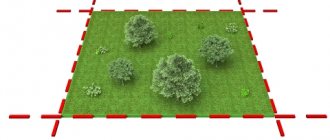You can obtain land for farming for free in your own possession and for rent for a certain period or indefinitely. This can be done by persons who have the status of Russian citizen or who do not. But at the same time, they must carry out their entrepreneurial activities within the framework of peasant farming.
- Law
- Who can get the land
- What land can be provided
- Required documents
- The procedure for obtaining land for peasant farms
- When they can refuse
- Is it possible to build on farm land?
Legislative regulation
The activities of peasant farms are regulated by the provisions of civil legislation and Federal Law-74 of June 11, 2003.
They determine the possibility of creating a farming enterprise for individual entrepreneurs and organizations, and accordingly the plot is transferred to organizations and entrepreneurs.
The main areas of activity of farmers are established:
- Production and processing of agricultural products and livestock products;
- Their transportation, preservation, sale.
On lands owned by peasant farms, the following can be carried out:
- Crop farming (growing grain, fodder and other crops, tobacco, etc.);
- Animal husbandry (breeding various animals - horses, goats, sheep, pigs, rabbits, raising poultry, deer, camels, silkworms, beekeeping);
- Vegetable growing (picking nuts, mushrooms, berries, growing fruits and grapes).
IMPORTANT! The farm's land can be used by all the people included in its composition to produce products for their own consumption. In this case, registration of a company or individual entrepreneur is not required.
Farm property means:
- Earth;
- Structures and buildings;
- Outbuildings (warehouses, sheds, etc.);
- Reclamation structures and irrigators;
- Agricultural equipment and special equipment;
- Draft animals and poultry;
- Machines and equipment.
The procedure for providing plots for peasant farms, the requirements for them and their purpose are determined in the Land Code of the Russian Federation and the Federal Law “On the turnover of agricultural land”.
How differences in agricultural industries affect accounting in them
Industry differences lead to the fact that the classification of the same types of activities for accounting purposes in agriculture may differ.
For example, for an enterprise producing compound feed, sowing and harvesting the corresponding crops, hay production will be the main activities. And for an enterprise specializing in fattening cattle, the same production of hay on existing hayfields will become an auxiliary production.
Accordingly, accounting will be provided in different ways:
- the feed manufacturer will take into account its costs for harvesting hay on account 20;
- and the owner of a meat farm - on account 23;
- Accounting for milk in agriculture is carried out on sub-accounts opened to accounts 20 “Milk Processing” and 10 “Milk” as a raw material.
Who can get the land
Individuals and companies have the opportunity to obtain land.
When applying for land, it is not necessary to register as an entrepreneur or organization. But if you are planning a business activity in the form of selling agricultural products, you will have to register it in the prescribed manner. Both citizens of the country and other people with citizenship of another state have the right to engage in farming. They can rent land from a private person or from the state, or buy it for their own ownership.
Who is eligible to receive?
Agricultural land plots that belong to the state or municipality can be transferred into ownership or lease:
- to individuals,
- legal entities.
The provision procedure is regulated by the Land Code of the Russian Federation and other regulations of federal and regional significance.
What land can be provided
Land areas issued to peasant farms have agricultural purposes. They should be located outside the rural settlement and include various objects on which there are forests, fields, reservoirs, buildings and structures, roads, and various communications.
Particularly valuable agricultural areas are under state protection. These include territories whose cadastre value is 10% higher than the municipal average, and artificially irrigated or drained plots.
The presented plot is considered indivisible, therefore its owners have shares in it without dividing them into parts. It will be possible to divide it only if the farm ceases to operate.
The presented lands may be used for the purposes for which they are presented. Their possible uses include the following varieties:
- Planting flowers;
- Breeding poultry and fish;
- Gardening and vegetable growing;
- Viticulture;
- Beekeeping;
- Hunting grounds;
- To organize fisheries;
- Haymaking and grazing of livestock;
- Creation of protective forest plantings.
The applicant can determine the required size of the transferred plot.
Briefly about the main thing
Thus, peasant farms are a universal option for immovable land property to meet rural and economic needs. To build on such a territory, a number of documents and permits are required. However, many concepts are not properly regulated by law.
| A little more attention! Write in the comments what you think - should only farmers manage land for peasant farms for themselves, or can it be considered as a business organization? |
Ratings 0
Read later
The procedure for obtaining land for peasant farms
This can be done in several ways:
- Organization of an auction initiated by municipal authorities when the plot falls within their sphere of disposal.
- Conducting a competition at the initiative of persons with the possible purchase of the object for personal ownership.
- Obtaining territory for rent without bidding for certain categories of persons.
- Lease obligations in relation to land that is not registered in the cadastral register, without tendering.
The provision of land for farming involves the following actions:
- Selecting the appropriate option . The selection can be made:
- By contacting your local municipality. They accumulate data on the presence of empty objects;
- By taking part in a public auction, information about which is published on electronic resources or in print media;
- Find information on the Rosreestr portal.
- Submission of an application for the allocation of land area . It is submitted to the administrative authorities authorized to accept it. The request must provide data about the object:
- Purpose of use:
- Authority of the applicant;
- Conditions for the transfer of land into ownership (free of charge or for a fee):
- The need to represent the territory of the required size (number of participants and employees, turnover volumes);
- Signed agreement on the establishment of a peasant farm;
- Temporary period, if the lease is intended for a short period.
applications for the provision of land for farming
The application is reviewed within 14 days, the draft boundary definition is approved in about one month.
- Organization of trades . Having received the application, the administration staff publishes a notice of intention to lease the land and invites applicants to participate in the competition. If no one has expressed a desire to participate in the event, the site is provided to the initiator without holding a tender. If there are still those interested, the rental price may increase significantly based on the results of the auction.
- Carrying out cadastral registration . In a situation where the administrative body has previously approved the application, the applicant must survey the property and register it at his own expense. Sometimes these costs are borne by the local municipality. The cadastral engineer of the land management organization establishes the boundaries of the territory, carries out topographic surveys and draws up the necessary documentation. Having received the papers, you need to submit them to Rosreestr to enter information into the unified cadastre and receive a passport.
ATTENTION! If the issuance of land is refused, the funds spent on the formation of the area will not be returned.
- If a positive decision is made in favor of the owner of the peasant farm, the administrative body signs an agreement with the applicant on the sale or lease of land property. It must indicate all the essential terms of the transaction, in particular:
- Amount of rental payments;
- Rights and obligations of the parties;
- Possibility of further purchase of the plot of land.
When its validity period expires, it can be:
- Extend;
- Terminate;
- Buy a plot of property
- Transfer of land into ownership . Land legislation determines the possibility of allocating agricultural territory for free lease with its subsequent transfer to private ownership if the site has been used for its intended purpose for five years. It can be purchased from the state after the end of the lease for a minimal amount.
IMPORTANT! The agreement must go through the registration procedure with Rosreestr, only after this the rights to own the plot will come into force.
Separation by production cycles
Another feature of agriculture is that the production cycle often does not coincide with the reporting year. An example is the cultivation of winter crops, which are sown in the fall of one year and harvested in the spring or summer of the next.
As a result, in the accounting of agricultural organizations, it is accepted to differentiate production costs by periods (years):
- costs of past periods (years) for the current harvest;
- expenses of the current period for the future harvest;
- expenses of the current period for the harvest in it.
To organize the distribution of direct costs, analytical subaccounts are opened on account 20. For example, 20/production of the reporting year and 20/production of the next year.
An additional nuance exists for distributed expenses. They are independent intermediate objects of cost accounting (see paragraph 44 of the methodological recommendations of the Ministry of Agriculture of Russia, approved by Order of the Ministry of Agriculture dated 06.06.2003 No. 792). That is, during the year, these expenses are taken into account in separate analytical accounts, and at the end they are distributed to cost analytics by year - for the harvest of the current year and the future.
Another nuance of cost formation, arising from the biological characteristics of agriculture, is the use of planned and actual costs.
A shifted production cycle is characterized by cost accounting at planned costs during the calendar year. The actual cost is determined once on the last day of the year through a special calculation. Identified deviations between fact and plan include:
- for products already sold in the reporting year - to the account of 90;
- the balance of finished products in warehouses - to account 43.
Example 2
Agronom LLC decided to sow winter wheat in 2021. In addition, the LLC also sows other grain crops. In 2022, it was discovered that frosts had killed about 20% of the winter crop.
In September 2022, the LLC made the following entries: Dt 20 (harvest 2021) Kt 10, 70, 69 - for the amount of direct actual costs for sowing winter crops - 1,000,000 rubles.
In December 2021, the LLC calculated the actual cost for 2021:
- Dt 20 (harvest 2020) Kt 20 (depreciation of fixed assets) - 200,000 rubles. (depreciation of used fixed assets distributed among types of crops for the current year’s harvest is written off);
- Dt 20 (harvest 2021) Kt 20 (depreciation of fixed assets) - 100,000 rubles. (distributed depreciation is written off for next year’s harvest);
- Dt 43 Kt 20 (harvest 2020) - 200,000 rub. (deviations of the fact from the plan are written off to the account of finished products of the current year).
In May 2022:
- Dt 20 (harvest 2021) Kt 10, 60, 70, 69 - 400,000 rub. (the costs of harvesting winter crops are taken into account at the planned cost);
- Dt 43 Kt 20 (harvest 2020) - 1,500,000 (1,000,000 100,000 400,000) rub. (the current cost of the winter crop harvest in 2019 has been formed);
- Dt 91 Kt 20 (crop loss - 2021) - RUB 300,000. (the loss from the destruction of crops is reflected in the accounting);
- Dt 90 Kt 43 - 1,500,000 rub. (the cost of sold winter crops has been written off).
In December 2022, the LLC will need to complete calculations for the 2021 winter crop harvest:
- Dt 20 (harvest 2021) Kt 20 (depreciation of fixed assets) - 100,000 rubles. (distributed depreciation of fixed assets for the 2021 season was written off);
- Dt 90 Kt 20 (destruction of crops) - 300,000 rubles. (the cost of the sold crop was reversed for the amount of loss from the loss of crops);
- Dt 90 Kt 20 (harvest 2021) - 100,000 rub. (the cost of the sold crop was adjusted by the amount of distributed expenses).
When they can refuse
An applicant may be denied agricultural land. Reasons for this may include:
- The required area is greater than the limits established by the administration of the village council;
- This is not a complete list of documents;
- The papers contain inconsistencies and inaccuracies;
- The object is burdened with the rights of interested parties.
The applicant is informed of the decision, indicating the reasons for the refusal. The unfoundedness of the arguments may serve to challenge them in court.
Nuances of buying and selling agricultural land
Transactions with this category of land plots are controlled by the state, due to the fact that these lands are considered particularly fertile.
When buying and selling such land, you need to consider some features:
- Citizens of other states are limited in purchasing such plots;
- One citizen cannot acquire more than 10% of the area of all lands of this category located in his area of residence;
- State bodies and municipalities have the preferential right to purchase and sell these plots.
The person who is the seller of the site is obliged to notify the local authorities in writing of the intention to sell.
The following shall be attached to such notice:
- Certificate confirming ownership of the plot;
- Copy;
- Site plan.
If government authorities ignored the notice or issued a written refusal to purchase, the seller can sell the plot to a third party. The sale period is 1 year. The cost should not be lower than that indicated in the notice.
If the seller decides to reduce the price, he again must notify government agencies about this. If this clause is violated, the transaction can not only be challenged, but declared void. This means that the state will take away the land.
Is it possible to build on farm land?
The construction of various non-agricultural buildings is allowed on the land territory of the peasant farm. These can be residential, industrial and recreational buildings. The area of such buildings cannot occupy more than 30% of the entire plot. The development is regulated by the emerging practice of the municipality and the approved project.
To officially register a residential building and register in it, it is necessary that its height does not exceed three floors. To build it, you need to provide evidence of the need for permanent human presence on the farm. This may be due to constant care of animals and other reasons.
The development of agricultural territories is regulated by the provisions of the Civil Code of the Russian Federation, which establishes the importance of compliance with urban planning, fire safety, construction, and sanitary standards during its implementation.
In addition to housing, the owner of a peasant farm can erect other buildings at will. The construction of permanent buildings must be accompanied by obtaining a construction permit. Temporary buildings can be erected without coordination with the relevant services. These can be sheds, warehouses, sheds and more. Their registration with Rosreestr is not required.
It should be noted that for the development of farming in Russia, agricultural land is provided for rent or for own ownership. Various products can be grown on them or livestock, fish and other animals can be raised. The maximum size of the territory provided will depend on the number of participants in the farm and the standards established in the region.










